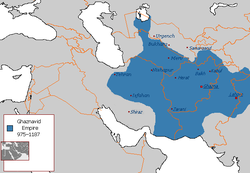கசானவித்து வம்சம்
غزنویان | |||||||||||||||||
|---|---|---|---|---|---|---|---|---|---|---|---|---|---|---|---|---|---|
| 977–1186 | |||||||||||||||||
 1030-இல் கசானவினித்துப் பேரரசு | |||||||||||||||||
| தலைநகரம் | கசானா (977–1163) லாகூர் (1163–1186)[1] | ||||||||||||||||
| பேசப்படும் மொழிகள் | பாரசீகம் (அலுவல் மற்றும் அரசவை மொழி[2] | ||||||||||||||||
| சமயம் | சுன்னி இசுலாம் | ||||||||||||||||
| அரசாங்கம் | பேரரசு | ||||||||||||||||
| சுல்தான் | |||||||||||||||||
• 977–997 | சபுக்திஜின் (முதல்) | ||||||||||||||||
• 1160–1186 | குஸ்ரௌ மாலிக்(இறுதி) | ||||||||||||||||
| அமைச்சர் | |||||||||||||||||
• 998–1013 | அபுல் ஹசன் இஸ்பரைனி (முதல்) | ||||||||||||||||
• 12-ஆம் நூற்றாண்டு | அபுல் மாலிக் நஸ்ருல்லா (இறுதி) | ||||||||||||||||
| வரலாற்று சகாப்தம் | மத்திய காலம் | ||||||||||||||||
• தொடக்கம் | 977 | ||||||||||||||||
• முடிவு | 1186 | ||||||||||||||||
| பரப்பு | |||||||||||||||||
| ஏறத்தாழ 1029[3][4] | 3,400,000 km2 (1,300,000 sq mi) | ||||||||||||||||
| |||||||||||||||||
கசானவித்து வம்சம் (Ghaznavid dynasty) (பாரசீக மொழி: غزنویان ġaznaviyān) கசானவித்துகள் பாரசீக சமூகத்தைச் சேர்ந்தவர்கள். [5] துருக்கி இசுலாமிய மம்லூக் எனும் அடிமை வம்ச மக்களின் வழித்தோன்றல்களே கசானவித்துகள் ஆவார்.[6]. கசானவித்துகள் புகழின் உச்சத்தில் இருந்த போது, 977 முதல் 1186 முடிய தற்கால, ஈரான், ஆப்கானித்தான், நடு ஆசியாவின் திரான்சாக்சியானா மற்றும் பாகிஸ்தான் பகுதிகளை ஆண்டனர். [7][8][9]
சமானித்து பேரரசில் படைத்தலைவராக இருந்த சபுக்திஜின் என்பவர், தற்கால ஆப்கானித்தானின் கசினி மாகாணத்தில், கிபி 977-இல் கசானவித்து வம்சத்தை நிறுவினார். [10] இவ்வம்சத்தினர் நடு ஆசியாவை சேர்ந்த மக்களாக இருந்த போதும், இவர்கள் பாரசீக மொழி, பண்பாடு மற்றும் நாகரீகங்களைப் பின்பற்றினர். இம்வம்ச மன்னர்களில் புகழ் பெற்றவர் கசினி முகமது ஆவார். இவ்வம்சத்தவர்களில் தலைநகரங்களாக கஜினி மற்றும் லாகூர் இருந்தது.
கசானவித்து வம்ச ஆட்சியாளர்கள்[தொகு]
- சபுக்திஜின் - 977–997
- இஸ்மாயில் 997–998
- கசினி முகமது - 998–1030
- முதலாம் மசூத் - 1030–1041
- சிகாப் உத்தௌலா - 1041–1048
- கசினியின் அலி - 1048–1049
- அப்துல் ரசீத் - 1049–1052
- தோக்ரூல் - 1052–1053
- பரூக்-சத் - 1053–1059
- இப்ராகிம் -1059–1099
- மூன்றாம் மசூத் - 1099–1115
- சிராஜ் - 1115–1116
- அர்ஸ்லான் இபின் மசூத் - 1116–1117
- பக்ரம் ஷா - 1117–1157
- குஷ்ரௌ-ஷா - 1157–1160
- குஸ்ரௌ மாலிக் - 1160–1186
இதனையும் காண்க[தொகு]
- மம்லூக்
- குவாரசமிய அரசமரபு (1077–1231)
- மம்லூக்கிய மரபு (தில்லி) - 1206 - 1290
- எகிப்தின் மம்லுக் சுல்தானகம் (1250–1517)
- சாமனித்து பேரரசு
அடிக்குறிப்புகள்[தொகு]
- ↑ "Lahore" Encyclopædia Britannica
- ↑ Homa Katouzian, "Iranian history and politics", Published by Routledge, 2003. pg 128: "Indeed, since the formation of the Ghaznavids state in the tenth century until the fall of Qajars at the beginning of the twentieth century, most parts of the Iranian cultural regions were ruled by Turkic-speaking dynasties most of the time. At the same time, the official language was Persian, the court literature was in Persian, and most of the chancellors, ministers, and mandarins were Persian speakers of the highest learning and ability"
- ↑ Turchin, Peter; Adams, Jonathan M.; Hall, Thomas D (December 2006). "East-West Orientation of Historical Empires". Journal of world-systems research 12 (2): 223. பன்னாட்டுத் தர தொடர் எண்:1076-156X. http://jwsr.pitt.edu/ojs/index.php/jwsr/article/view/369/381. பார்த்த நாள்: 16 September 2016.
- ↑ Rein Taagepera (September 1997). "Expansion and Contraction Patterns of Large Polities: Context for Russia". International Studies Quarterly 41 (3): 496. doi:10.1111/0020-8833.00053. https://www.jstor.org/stable/2600793. பார்த்த நாள்: 16 September 2016.
- ↑ Böwering, Gerhard; Crone, Patricia; Mirza, Mahan (January 1, 2012). The Princeton Encyclopedia of Islamic Political Thought. Princeton University Press. பக். 410–411.
- ↑ Islamic Central Asia: an anthology of historical sources, Ed. Scott Cameron Levi and Ron Sela, (Indiana University Press, 2010), 83;The Ghaznavids were a dynasty of Turkic slave-soldiers..., "Ghaznavid Dynasty" Encyclopædia BritannicaJonathan M. Bloom, Sheila Blair, The Grove Encyclopedia of Islamic Art and Architecture, Oxford University Press, 2009, Vol.2, p.163, Online Edition, "Turkish dominated mamluk regiments...dynasty of mamluk origin (the GHAZNAVID line) carved out an empire..."
- ↑ C.E. Bosworth: The Ghaznavids. Edinburgh, 1963
- ↑ C.E. Bosworth, "Ghaznavids" in Encyclopaedia Iranica, Online Edition 2006
- ↑ C.E. Bosworth, "Ghaznavids", in Encyclopaedia of Islam, Online Edition; Brill, Leiden; 2006/2007
- ↑ Encyclopædia Britannica, "Ghaznavid Dynasty", Online Edition 2007
மேலும் படிக்க[தொகு]
- Bosworth, Clifford Edmund (1963) The Ghaznavids: Their Empire in Afghanistan and Eastern Iran 994–1040 Edinburgh University Press, Edinburgh, இணையக் கணினி நூலக மையம் 3601436
- Bosworth, Clifford Edmund (1977) The Later Ghaznavids: Splendour and Decay, The Dynasty in Afghanistan and Northern India 1040–1186 Columbia University Press, New York, பன்னாட்டுத் தரப்புத்தக எண் 0-231-04428-3
- Bosworth, Clifford Edmund (1998), "THE GHAZNAVIDS", in Asimov, M.S.; Bosworth, C.E. (eds.), History of Civilisations of Central Asia (PDF), UNESCO Publishing, ISBN 978-92-3-103467-1
- M. Ismail Marcinkowski (2003) Persian Historiography and Geography: Bertold Spuler on Major Works Produced in Iran, the Caucasus, Central Asia, India and Early Ottoman Turkey Pustaka Nasional, Singapore, பன்னாட்டுத் தரப்புத்தக எண் 9971-77-488-7
வெளி இணைப்புகள்[தொகு]
- Coins of Ghaznavid Rulers
- Mahmud of Ghazna Columbia Encyclopedia (Sixth Edition)
- Mahmud Encyclopædia Britannica (Online Edition)
- Ghaznavid Dynasty Encyclopædia Britannica (Online Edition)
- Ghaznavids and Ghurids Encyclopædia Britannica (Online Edition)
- Mahmud Ghaznavi's 17 invasions of India
- The History of India, as Told by Its Own Historians. The Muhammadan Periodby Sir H. M. Elliot; Edited by John Dowson; London Trubner Company 1867–1877 Elliot, Sir H. M., Edited by Dowson, John. The History of India, as Told by Its Own Historians. The Muhammadan Periodpublished by London Trubner Company 1867–1877. (Online Copy: – Online version posted by: The Packard Humanities Institute; Persian Texts in translation)
- Afghan secrets revealed on Google Earth
 Ethé, Karl Hermann (1911). "Persia". பிரித்தானிக்கா கலைக்களஞ்சியம் (11th) 21. Cambridge University Press. 187–252.
Ethé, Karl Hermann (1911). "Persia". பிரித்தானிக்கா கலைக்களஞ்சியம் (11th) 21. Cambridge University Press. 187–252.

